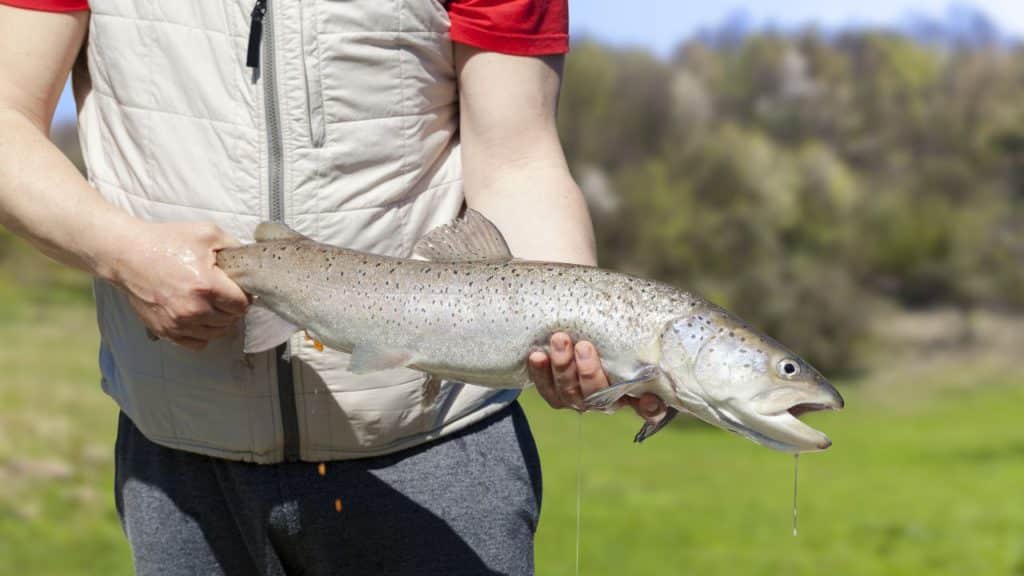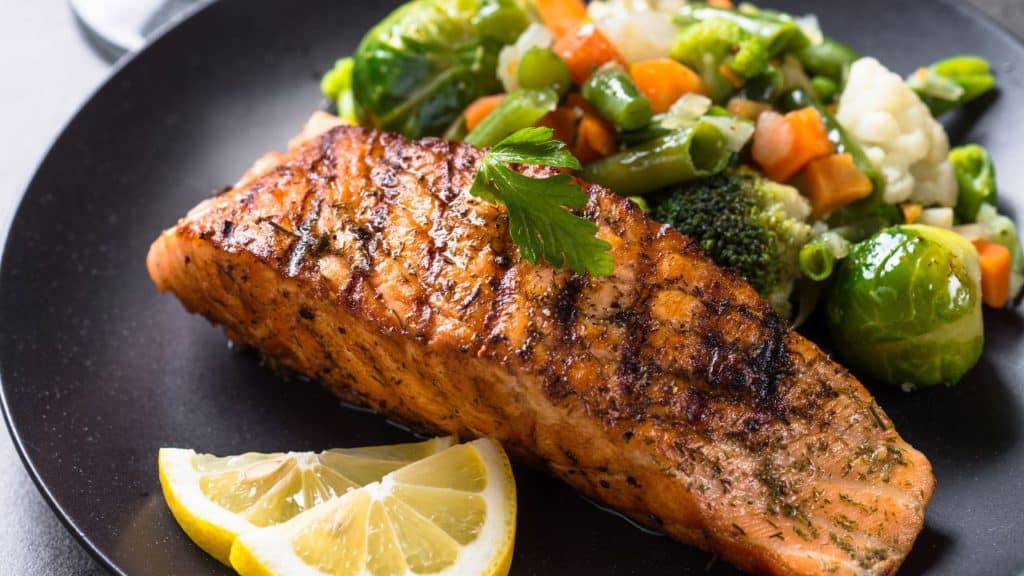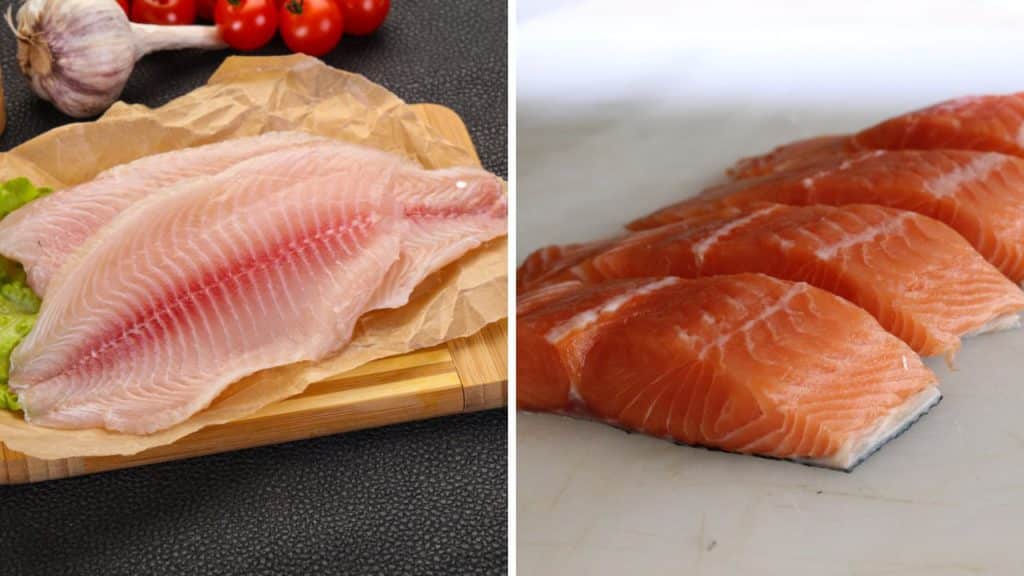Tilapia vs. salmon? The United States Food and Drug Administration (FDA) and the Environmental Protection (EPA) list salmon and tilapia among the best choices for fish consumption because they are nutritious and are generally low in mercury levels. But what makes one fish better than the other? In this article, we’ll talk about the seven key differences between these types of fish, including their nutritional value.
Tilapia vs. Salmon Comparison Table
| Tilapia | Salmon | |
| Scientific Name | Oreochromis | Salmo salar |
| Family | Cichlidae | Salmonidae |
| Also known as | Hawaiian Sunfish | Atlantic Salmon |
| Habitat | Warm Freshwater | Freshwater and Saltwater |
| Average Size and Weight | Size: 20-38cmWeight: 2-4 pounds | Size: 36-63 cmWeight: 7.9 -12 pounds |
| Diet | Wild: AlgaeFarmed: Corn or Soybean meal | Insects, amphibians, and small fish |
| Hunting Behavior | Aggressive | Territorial |
| Physical Features | Laterally compressed with long dorsal fins | Silver-colored skin/ bright pink with eight fins arranged in pairs |
| Meat (texture and color) | White, tender with a flaky texture | Bright pink-orange color with a soft, buttery, or creamy smooth texture. |
Family
The name “salmon” refers to several fish species belonging to the Salmonidae family. Other species in this family include char, trout, whitefish, and grayling. The family of salmon has two genera: the genus Salmo and the genus Oncorhynchus.
Currently, there are eight species of salmon. The most common species include the Chinook, Atlantic, and Sockeye.
On the other hand, tilapia belongs to the Cichlidae family. The Cichlidae family has three genera: Sarotherodon, Tilapia, and Oreochromis. The Tilapia genus is further subdivided into 42 other species.
Habitat
Tilapias are freshwater fish living in shallow streams, lakes, and rivers. They are also in many brackish and fresh tropical and subtropical habitats. However, most tilapias for human consumption are farm-raised in ponds.
On the other hand, almost all salmon species share similar habitat choices. Adult salmon lay their eggs in freshwater rivers, creeks, and streams, where they hatch. After they mature, salmon move to salty waters, especially in oceans and seas. They only return to freshwater habitats when it’s time to reproduce.
Size and Weight

The size and weight of salmon and tilapia depend on the stage of their lives. Small salmon are usually less than 63cm long, while mature salmon are around 70-75cm long. The average weight of an adult salmon is between 7.9 -12 pounds.
Generally, tilapia can grow up to a length of 30cm. Small tilapia grow rapidly but stall when they are 3 to 5 years old. At this age, most tilapias weigh about 2-4 pounds. However, there are cases where tilapia can weigh up to ten pounds.
Physical Features
Tilapias are among the most farmed fish on earth as they grow fast and are in high demand. They have a shape like a crappie and a sunfish with an interrupted lateral line. They are also laterally compressed, and their deep bodies have long dorsal fins.
In addition, tilapias have spines in their anal and pelvic fins, but the spine in their dorsal fins is long. You will also identify wide vertical bars with dark coloration along the sides of the fingerings.
Unlike tilapia, salmon are more saltwater fish and have long, thin bodies. At a glance, you will notice that salmon have blunt nose and small head, and their mouth extends below the eye. Adult salmon have a silver appearance and white underside, with a distinct dark blue-green spot all over their body.
Diet

What salmon feed on depends on the stages of their lives. Young salmon live in rivers and feed on aquatic insect larvae like stoneflies and mayflies. Mature salmon feed on zooplankton, small fish like sand lances, and fish larvae.
Contrastingly, in this tilapia vs. salmon comparison, tilapias are herbivores and like feeding on algae, plankton, and other vegetable matter. Their diet option protects them from accumulating toxins. Farmed tilapia usually feed on food made of corn and soybean.
In most countries, people who keep tilapia in ponds feed them with livestock feces like sheep and poultry. However, this behavior is uncommon in the US, as the fish ponds and tilapia farms are monitored carefully.
Tilapia vs. Salmon: Nutritional Value

| Tilapia | Salmon | |
| Calories | 96 | 179 |
| Fat(g) | 1.7 | 10.4 |
| Cholesterol (mg) | 57 | 63 |
| Protein (g) | 20.1 | 19.9 |
| Sodium (mg) | 52 | 47 |
| Carbs (g) | 0 | 0 |
| Omega 3 (mg) | 220 | 2,342 |
| Omega- 6(mg) | 210 | 122 |
| Phosphorus | 17 | 29 |
| Magnesium | 7 | 24 |
| Vitamin B12 (%DRV) | 26 | 22 |
| Folate | 6 | 34 |
| Zinc | 0.41 | 0.43 |
| Copper | 0.075 | 0.049 |
Protein
Both tilapia and salmon contain high amounts of protein. However, the protein content in tilapia is slightly higher than in salmon. For example, a 100 grams portion of tilapia has 20.1 grams of protein.
On the other hand, a 100 grams portion of tilapia contains 19.9 grams of protein. This means there is a difference of 0.2 grams, but this difference gap is slight.
Fats
Salmon has higher fat content compared to tilapia. One hundred grams of a salmon filet has 10.4 grams of fat, while the same portion for tilapia contains 1.7 grams. That means salmon’s fat content is six times higher than tilapia’s. The difference in fat content explains why tilapia has higher calorie content than salmon.
Although salmon has higher fat content, it’s healthier than tilapia. This is because salmon contains monounsaturated fats that are beneficial to your body. Studies show that these fats can improve your blood cholesterol and reduce inflammation.
Furthermore, people who consume monounsaturated fat lessen the chances of developing diabetes and high blood pressure.
Calories
Salmon has higher calorie content compared to tilapia. For example, 100 grams of tilapia contains 96 calories, while the same quantity of salmon contains 142 calories. Although tilapia has fewer calories, salmon is the healthier option since most calories are from healthy fats.
Minerals
Both species are rich in minerals that have numerous health benefits. Salmon is rich in phosphorus, niacin, and magnesium. Niacin can help lower cardiovascular diseases, while phosphorus promotes healthier bones. Magnesium plays a vital role in muscle function and helps convert food into energy.
Tilapia is a good source of selenium, a good antioxidant that controls inflammation and boosts your immune system.
Remember, both options are excellent sources of iron, calcium, sodium, potassium, copper, magnesium, and zinc sources. However, salmon contains more phosphorus, while tilapia contains more iron, magnesium, and copper.
Vitamins
Both salmon and tilapia are rich in vitamins, but salmon boost a higher vitamin profile. Both species are rich in Vitamin A, Vitamin K, Vitamin E, Vitamin D, Vitamin C, and Vitamin Bs. However, salmon contains more Vitamin B6, Vitamin B2, Vitamin B12, Vitamin D, and Folate. The only vitamin that tilapia has higher in content than salmon is Vitamin K.
Micronutrients
With sodium content of just 52mg and 47mg, both fish are perfect for people on a low-sodium diet. Another micronutrient worth mentioning is omega-6. Tilapia’s content is higher than that of salmon. Keep in mind that excessive consumption of tilapia can increase inflammation as omega-6 has inflammatory properties.
Taste

Tilapia’s flaky white meat has a mild flavor. Depending on your preference, you can prepare it by frying, baking, deep frying, grilling, or boiling.
On the other hand, salmon has a more robust flavor and a somewhat mild taste. Remember that salmon has a higher fat content, giving it an oily taste. Salmon is tastier than tilapia if you are okay with the fishy taste you get while eating it.
Like tilapia, you can prepare salmon differently to tweak its taste. The best way to prepare it is by filleting and marinating it with spices or lemon.
And the Winner Is?
Hopefully, this tilapia vs. salmon comparison has helped you better understand these two fish species. Remember, both are good choices for consumption. Salmon has a slight advantage because of its high omega-3 fatty acids content.
Table of Contents



